Critical SAM registration mistakes to avoid in 2025 include submitting incomplete documentation, failing to align business information across federal databases, overlooking TIN/name matching requirements, neglecting point of contact management, ignoring notification emails, missing renewal deadlines, using inconsistent address formatting, and delaying updates after business structure changes. These errors can result in registration rejection, processing delays, loss of contract eligibility, and compliance violations. The following extensive guide offers strategic solutions to maintain SAM compliance and protect contracting opportunities.
10 Critical SAM Registration Mistakes to Avoid in 2025 [Expert Guide
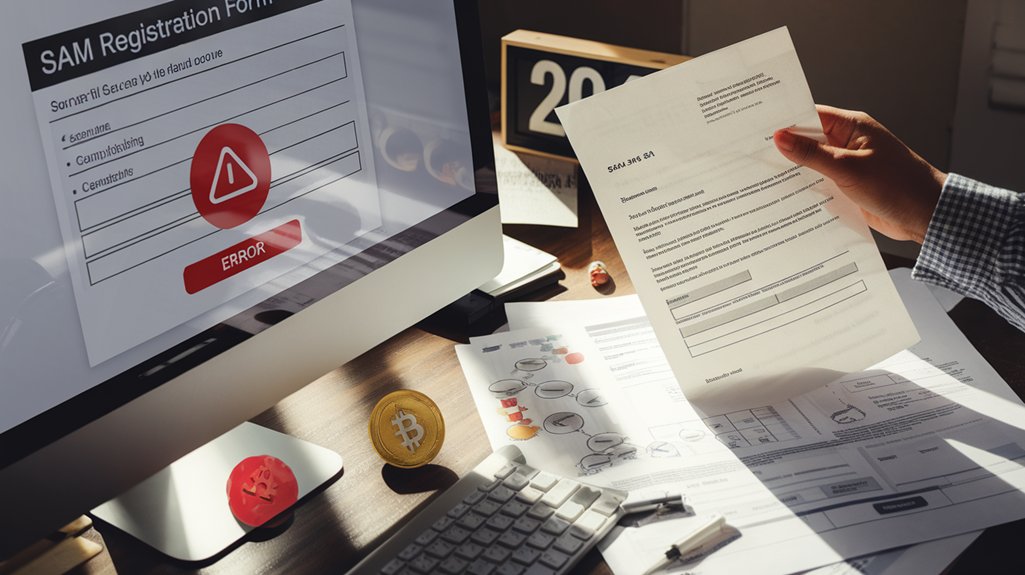
As businesses prepare for government contracting opportunities in 2025, avoiding common SAM registration mistakes has become increasingly significant for successful participation in federal procurement. Companies must carefully verify that their Business Structure documentation aligns perfectly with what is registered in SAM to prevent application rejection.
The Registration Process requires meticulous attention to technical details, particularly regarding CAGE codes and D-U-N-S numbers. Contractors should verify these identifiers are accurately entered and consistent across all systems. Entities must be prepared to update CAGE information promptly when business details change to avoid payment delays and contract issues.
Legal business name discrepancies between SAM, IRS records, and official documents frequently cause preventable delays. Address consistency across SAM, IRS, and Dun & Bradstreet databases is essential for validation. Many businesses face setbacks when addresses don’t match exactly across these platforms. A comprehensive compliance checklist can help organizations systematically verify all required information and maintain federal eligibility. Experts recommend conducting regular reviews of all business information to identify and correct minor discrepancies before they cause registration issues.
Organizations should consider professional guidance when maneuvering technical challenges, especially when maintaining proper documentation or handling complex registration requirements specific to their business type.
Submitting Incomplete Documentation and Missing Critical Attachments

The submission of incomplete documentation represents one of the most prevalent pitfalls in the SAM registration process, often causing significant delays and potential application rejection.
Document verification requires meticulous attention to detail, with tax returns, incorporation documents, and utility bills all serving as critical components for validation.
Entities frequently overlook key attachments such as stock ownership certificates, lease agreements, and EIN confirmation documents, compromising submission accuracy.
These omissions can lead to registration delays, increased administrative burden, and even risk of registration inactivation.
To avoid these issues, organizations should:
- Create a centralized document repository
- Regularly review and update all documentation
- Maintain a thorough checklist of required attachments
- Use secure communication channels for document transmission
- Respond promptly to any additional documentation requests from SAM.gov
Organizations must carefully verify their physical address through the USPS database, as incorrect address information could lead to verification failure and registration rejection.
Having your D-U-N-S Number readily available is essential for completing the SAM registration process without unnecessary complications.
Proper documentation management guarantees smoother registration and helps prevent costly delays in the federal contracting process.
Organizations facing documentation challenges can utilize Alaska APEX Accelerator for specialized one-on-one technical assistance throughout the SAM registration process.
Failing to Align Business Information Across Federal Databases
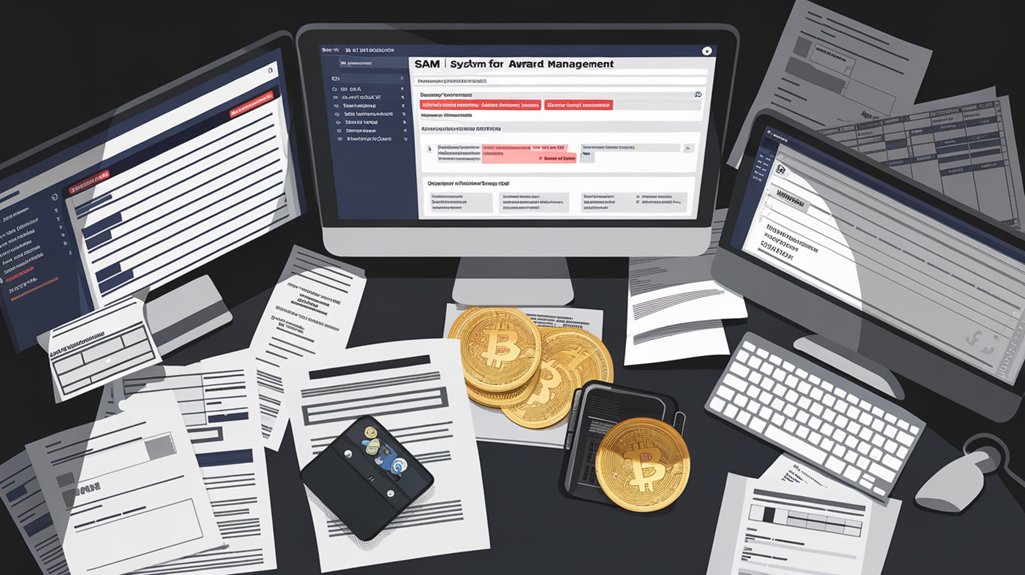
Numerous organizations jeopardize their SAM registration by failing to maintain consistent business information across federal databases, creating significant compliance risks and processing delays.
Effective business data synchronization requires that legal names, physical addresses, and other critical details match exactly across all government systems, particularly with IRS records.
Federal database accuracy impacts every stage of the federal contracting process. When inconsistencies exist between SAM and other databases, contractors face potential contract rejections, award delays, and missed business opportunities.
The Unique Entity Identifier (UEI) must remain current and consistent throughout all systems.
Contractors should implement regular verification processes to guarantee information alignment across platforms. This includes establishing a single source of truth for business information and conducting quarterly audits of database entries.
Such proactive measures prevent the regulatory scrutiny and reputation damage that often result from information misalignment in federal systems.
The November 2024 FAR Council interim rule clarifies that contractors need only be registered in SAM at bid submission and at award, not continuously throughout the pre-award process.
Companies must ensure their registered business name includes all appropriate legal suffixes such as ‘LLC,’ ‘Inc.,’ or ‘Corp.’ to match IRS records exactly.
Regular profile updates are essential for maintaining credibility and competitiveness when pursuing government contracts.
Overlooking Tin/Name Matching Requirements With the IRS
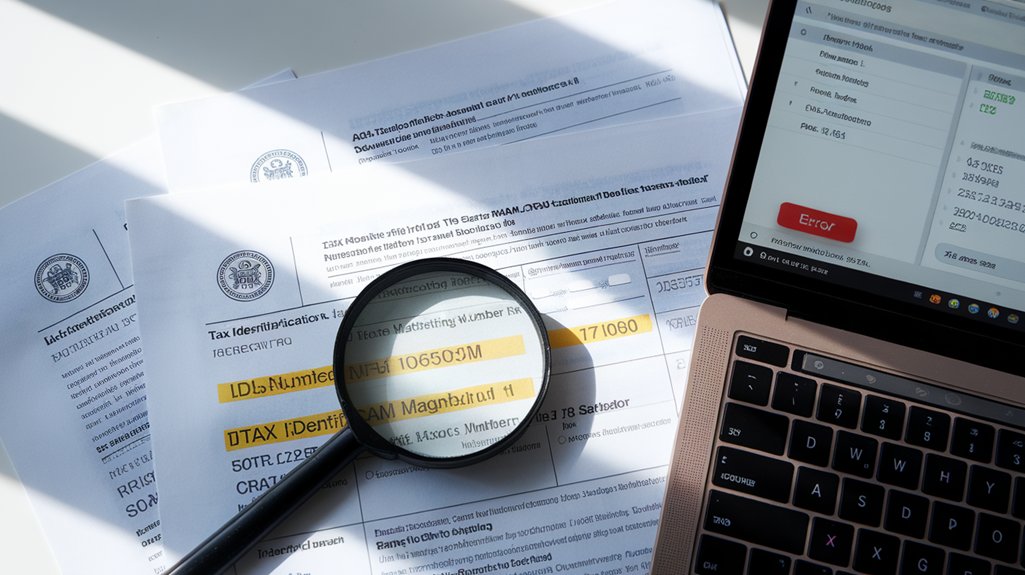
Many federal contractors compromise their SAM registration by neglecting the critical TIN/Name matching requirements established by the IRS, leading to registration delays and potential disqualification from government contracts.
The TIN verification importance cannot be overstated, as it serves as a cornerstone of proper IRS compliance strategies.
When implementing TIN verification processes, contractors should:
- Register for the IRS e-services portal before attempting TIN matching procedures
- Verify TIN and legal business name match exactly across all federal databases
- Address any discrepancies immediately upon receiving non-match codes (anything other than “0”)
- Conduct TIN matching well before SAM registration deadlines to allow time for corrections
Proactive verification prevents backup withholding notices (CP2100) and associated penalties. The IRS returns nine different codes to indicate various outcomes of the verification process, with only code “0” representing a complete match.
Contractors who prioritize this step demonstrate their commitment to compliance while avoiding unnecessary complications that could jeopardize their eligibility for federal opportunities. Ensuring the documentation accuracy throughout the SAM registration process is essential to navigate the often complex procedure successfully.
Neglecting Proper Point of Contact Management and Security Protocols

Several government contractors lose their SAM.gov registration status annually due to inadequate point of contact management and insufficient security protocols, creating communication gaps that prevent timely responses to federal requirements.
Successful SAM.gov maintenance requires meticulous point contact information management, including valid email addresses for all designated representatives. Organizations must implement clear role assignments for each contact person and conduct quarterly audits of this information to prevent registration lapses. Entity registration requires creating an individual profile first, which serves as the foundation for the entire SAM.gov registration process.
Security protocols represent another critical area often overlooked by contractors. Implementing strong password management practices, enabling two-factor authentication, and restricting SAM.gov access to authorized personnel greatly reduces breach risks.
Companies should maintain detailed documentation of all system access protocols and develop incident response plans for potential security events. Annual renewal of your registration is mandatory to maintain eligibility for federal contracts and prevent costly compliance issues.
Regular verification of entity information, including physical addresses through USPS zip lookup tools, guarantees alignment with government databases and prevents communication failures that could jeopardize contract eligibility.
Misunderstanding the SAM.gov Technical Process Requirements

Government contractors frequently encounter registration complications due to insufficient knowledge of SAM.gov‘s technical requirements, which can lead to delays, rejection, or even deactivation of their profiles. Understanding the technical parameters is essential for successful registration and maintenance.
Mastering SAM.gov’s technical specifications prevents costly delays and ensures continuous eligibility for government contracts.
- Browser compatibility issues remain one of the most common obstacles, as SAM.gov functions effectively only with specific browsers and requires regular software updates for proper form submission.
- The entity validation process requires original documentation submission and may take additional time when information doesn’t match existing records.
- Scheduled maintenance periods (Tuesday, Thursday, and Friday from 8:00-10:00 PM EST) prevent registration activities, requiring contractors to plan accordingly.
- Legacy system shifts have moved several functions to SAM.gov, including FAPIIS and subaward reporting previously handled through FSRS.gov, requiring users to locate features in their new environment.
Regularly monitoring your registration status indicators on the SAM.gov dashboard is crucial for identifying technical issues before they delay your application process.
Ignoring Important Notification Emails and System Alerts

Overlooking critical communications from SAM.gov creates significant vulnerabilities that can derail government contracting efforts and compromise registration status.
The system’s notification routing mechanisms require careful configuration to prevent single-point failures, particularly when multiple users should receive alerts about registration changes.
Organizations frequently fall victim to sophisticated phishing tactics when they fail to verify sender domains, mistaking addresses like @sam-gov.net for legitimate communications.
These scams often use urgent language to prompt immediate action on fraudulent invoices or renewal notices.
SAM.gov users should always check for official SAM.gov branding when receiving communications to help distinguish authentic messages from potential scams.
Common notification management errors include:
- Disabling email alerts in system settings
- Using personal rather than institutional email addresses
- Neglecting to activate “follow record” notifications
- Missing deadline-sensitive communications due to ambiguous subject lines
- Overlooking authentication requirement updates
Properly configuring the notification frequency settings in your profile section can prevent missing updates about contract changes and wage determinations that affect compliance.
Post-FSRS.gov change, organizations must pay special attention to subaward reporting alerts and new validation protocols to maintain compliance and avoid potential registration lapses.
It’s essential to remember that legitimate SAM communications will only come from .gov email addresses, which is a key indicator to distinguish between official messages and potential scams.
Missing Annual Renewal Deadlines and Verification Windows
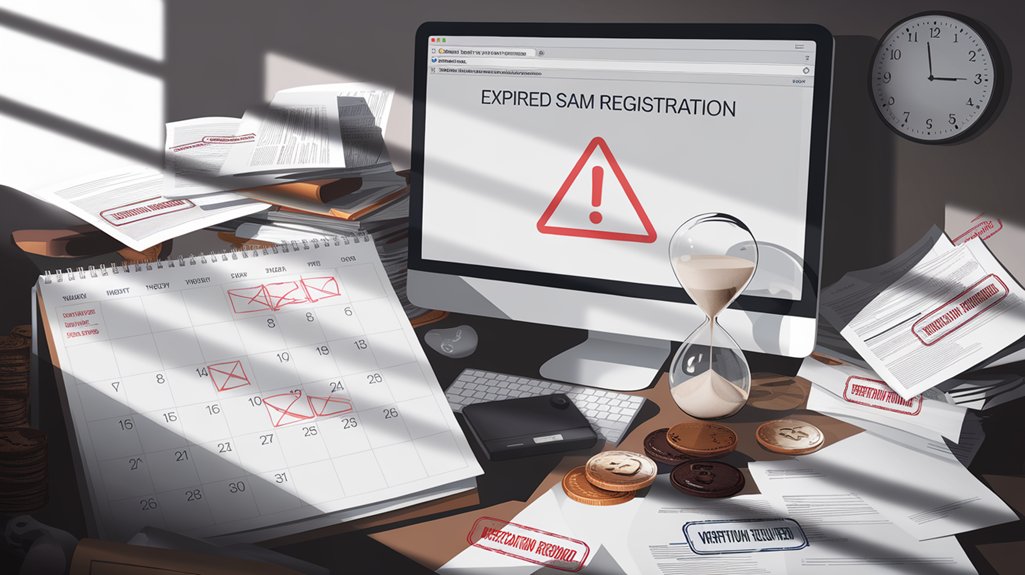
Three critical deadlines mark the SAM.gov renewal process, creating potential pitfalls for unprepared entities seeking to maintain federal contracting eligibility. The annual renewal requirement demands attention every 365 days, with no automatic renewal feature to rely upon.
Failing to meet these deadlines results in severe registration consequences, including immediate loss of eligibility for federal contracts and grants. GSE provides automatic renewal reminders through their SAM Management Program to help businesses avoid missing critical deadlines. This expiration can significantly impact your business’s credibility with officials and potentially disqualify you from future opportunities. Early preparation can prevent service disruptions and ensure continued eligibility for government contracts.
- Verification Window Management – Timely verification of entity information prevents processing delays that can extend beyond the 10-business-day standard review period.
- Documentation Preparation – Gathering accurate financial data and business information before the renewal date prevents last-minute scrambling.
- UEI Validation – Ensuring your Unique Entity ID remains valid and properly connected to your registration.
- System Alert Monitoring – Regularly checking SAM.gov communications about deadlines and system changes helps prevent unexpected registration lapses.
Using Inconsistent Address Formatting Across Registration Systems

Precision in address formatting represents one of the most overlooked yet critical elements of successful SAM registration maintenance. The USPS database serves as the federal standard against which all physical addresses are validated, making address standardization essential for approval.
Address standardization against the USPS database is not optional—it’s the cornerstone of SAM registration success.
When addresses differ between SAM.gov and supporting documentation like IRS records or banking information, entities face immediate rejection or payment delays.
Format consistency becomes particularly challenging when managing multiple systems with conflicting requirements. SAM.gov often requires different abbreviations than state incorporation databases or federal contractor portals. These inconsistencies create compliance red flags that can suspend bidding privileges during reconciliation. Maintaining correct address information is essential for active SAM status and continuing eligibility for federal opportunities.
Inconsistent address formatting often stems from the same naming convention issues that plague business identifiers across different government platforms.
Effective mitigation strategies include:
- Implementing address-validation APIs before submission
- Maintaining centralized address records with version control
- Conducting quarterly cross-checks against IRS/TIN data
- Using SAM.gov’s address preview function
- Engaging third-party validators for international addresses
Failing to Update Business Structure Changes in a Timely Manner
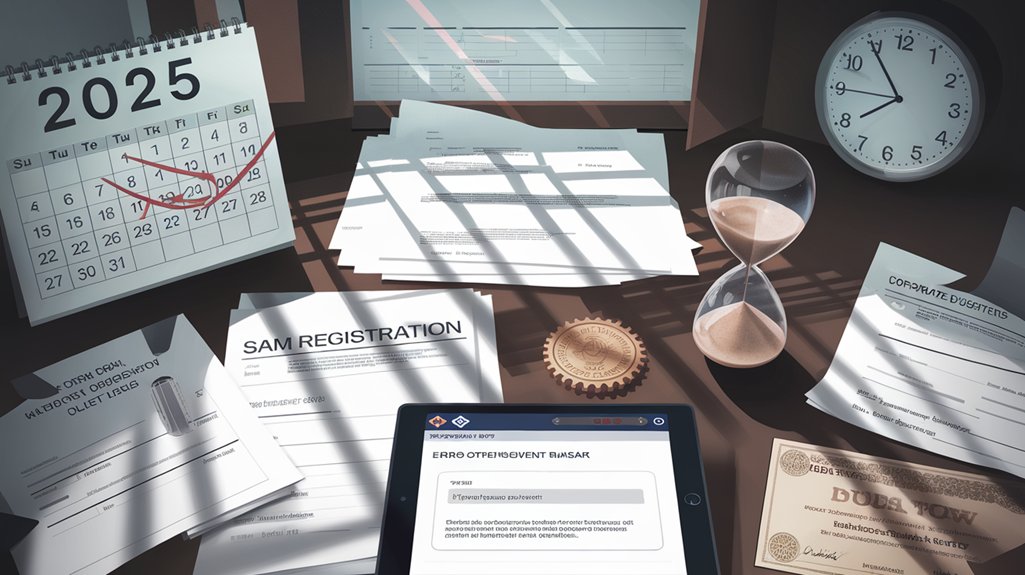
When a business undergoes structural changes, such as mergers, acquisitions, or shifts in ownership, immediate updates to SAM registration become essential for maintaining federal contracting eligibility.
Neglecting to update your legal structure information promptly can result in serious consequences for your government contracting activities.
The impact of delayed SAM updates includes:
- Loss of contract eligibility – Outdated business information may disqualify your company from bidding opportunities and current contracts.
- Processing delays – SAM verification checks require time to process, creating additional waiting periods when updates are submitted late.
- Compliance violations – Failure to maintain current registration details may violate federal contracting regulations.
- Missed opportunities – Government agencies cannot engage with entities whose SAM profiles don’t reflect their current legal structure.
During the update process, supporting documentation may be requested to verify the legitimacy of your business structure changes.
Nonprofit organizations must be particularly vigilant about maintaining their charitable status in SAM to ensure continued access to federal funding opportunities.
Best practice dictates an update frequency of immediately following any structural change, with quarterly reviews of all SAM information regardless of changes. Your profile must include your current Unique Entity Identifier to ensure proper identification in the government database.
Frequently Asked Questions
How Long Does SAM Registration Last Before Requiring Renewal?
SAM registration duration is exactly 365 days, requiring annual renewal to maintain active status in the system.
The renewal process should begin approximately two months before expiration to allow sufficient processing time, which typically takes up to 10 business days.
Organizations must complete this renewal manually, as the system does not offer automatic renewal options.
Failure to renew on time results in inactive status, which prevents participation in federal procurement opportunities and may disrupt ongoing business operations.
Can I Register in SAM.Gov Without a Duns/Uei Number?
No, entities cannot register in SAM.gov without a UEI number.
The DUNS number system has been phased out completely. The UEI number is now mandatory for all SAM.gov registrations.
Entities must obtain a UEI through the SAM.gov website as part of the validation process before completing their registration.
This identifier is essential for federal contracting and receiving government funds.
Are SAM Registration Services Worth the Cost Versus Self-Registration?
SAM registration services offer clear advantages in a cost comparison with DIY methods.
While self-registration is free, it typically requires 10-20 hours of work and risks costly errors that may disqualify contracts.
Professional services ($300-$800) enhance registration efficiency by handling technical requirements like NAICS codes, entity validation, and multi-system integration.
For businesses valuing time and compliance accuracy, especially those pursuing special designations like 8(a) or WOSB, the service investment often proves worthwhile.
How Quickly Can I Bid on Contracts After Completing Registration?
Vendors can bid on federal contracts immediately after their SAM registration becomes active with “Registration Status: Active” shown on their profile.
However, the bidding timeline can include 24-48 hour system processing delays after submission.
Contract eligibility requires complete validation, including TIN matching and CAGE code assignment.
Entities should plan for potential roadblocks like bank account validation failures or UEI verification issues.
A 10+ week buffer before intended bidding provides time to resolve any registration complications.
What Happens if My Business Relocates During Active SAM Registration?
When a business relocates during active SAM registration, addressing relocation promptly is essential.
Companies must update their business information within 30 days of moving to maintain compliance with federal regulations. Failing to update can result in disqualified bids, payment delays, and potential loss of certifications.
The process requires updating the physical address, validating entity records, reconfirming banking details, and updating the Electronic Business Point of Contact to guarantee continuous eligibility for federal contracts.